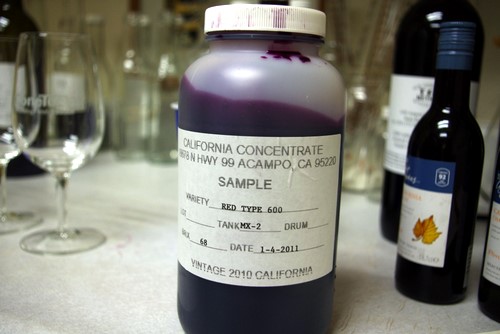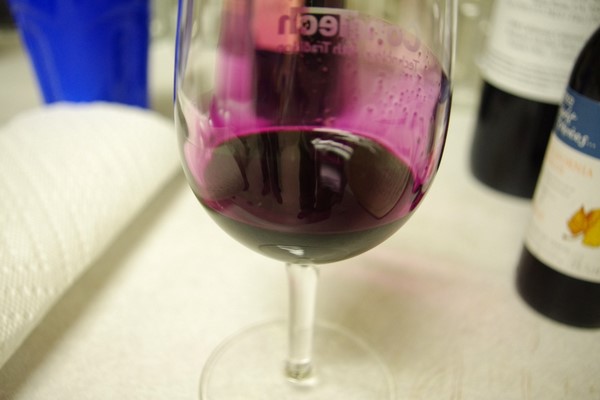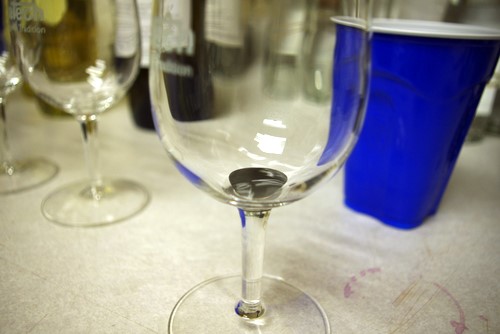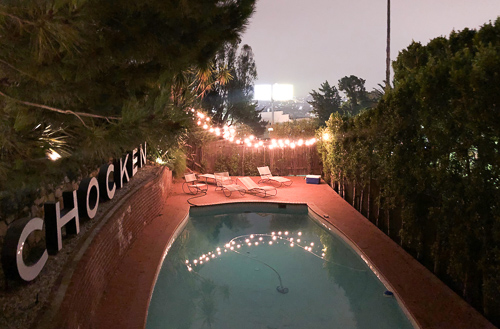Grape juice concentrate is a controversial topic in winemaking. It’s widely used, but people don’t really like to talk about it, because it sounds a bit like cheating. It’s a brave winemaker who shows journalists this widely used trick of the trade. Normally, it’s kept hidden away.
Most controversial of all is a substance called Mega Purple. This is (supposedly) frequently used in California to add colour to wines, as well as a little sweetness, and has caused quite a stir – perhaps, in part, because of the name. On a recent trip to California I got to see, for the first time, both regular grape juice concentrate, and also Mega Purple.
Grape juice concentrate is made by concentrating unfermented grape juice, typically by boiling it in a partial vacuum, which lowers the boiling point to a temperature where the flavours aren’t completely cooked. It’s then added to wines that have already fermented to dryness at the blending stage.
Many commercial red wines will end up with 4–5 g/litre residual sugar, which will all be from the addition of concentrate. Some have as high as 10 g/litre, which gives them a bit of perceptible sweetness: YellowTail is a famous example of this. A little bit of sugar rounds out the palate and adds to the perception of fruitiness. It also masks harsh tannins and covers over a bit of greenness. Concentrate is typically 68 °Brix (i.e. 68 g sugar in 100 ml, or 680 g/litre sugar): it’s viscous and intensely sweet.
Mega Purple also adds a bit of sweetness, but is mainly used to add colour. It is also grape juice concentrate, but it is made from a teinturier (red fleshed) Vitis vinifera variety called Rubired, which explains its intense colour. Mega Purple is produced by Constellation-owned Canandaigua. It’s expensive, at around $125 a gallon, but very little is needed. The pictures show the effect of diluting a small drop (in the top picture of the two) with water. It doesn’t really smell of much. Typical additions would be 0.2%. There’s also a Mega Red, apparently.
Are these additions to wine evil? Are they cheating? They’re not terribly natural, but because they are derived from grapes, you could argue that for inexpensive commercial styles, there is nothing terribly wrong with them. It is not the same as adding flavourants to wine, for example. Personally, I would rather drink wines that don’t have these additions. But I can understand that these sorts of tools can make cheap wines that non-involved consumers prefer the taste of. If the existence of tasty, accessible, cheap wines helps recruit new wine drinkers, there’s every chance that some of these new drinkers will move on from these entry level wines to more interesting offerings.
I don’t feel like starting a crusade against grape juice concentrate. But I would be happier if fewer winemakers resorted to these tricks. In an ideal world people would make good, inexpensive wines more naturally.
44 Comments on Grape juice concentrate and Mega Purple





Jamie- as a winemaker, I deplore the notion that concentrate should be added to make a “better” wine. Better how? Darker color? A touch of sweetness- (below the point where it is indetifiable as such, but still “rounds out” the mid palate)?? Nasty, nasty, nasty.
But in thirty years in and around this industry, I have yet to know a single Pinot producer who actually uses this stuff or its “red” counterpart- it is far more widely used in the juice industry. Even in that “other” valley to the east of us where a lot of cab is grown and made, I know many winemakers, we all speak frankly, and this stuff is just not well thought of by high end producers. To be sure, some is used in wine: generally mass produced- low end plonk. But for high end wines this remains far more urban legend than actual fact.
agreed—and stop winemakers adding sugar or water while you are at it
I agree that using Mega Purple is cheating, but is it evil to add a little white grape concentrate to a Pinot Grigio before bottling, if your customers prefer off-dry (like .5 RS?) The alternative is to waste energy by keeping the wine below 30F for months, or to overprocess the wine by sterile filtration.
I doubt if these additives improve fruit from good North Coast vineyards, but how do you tell people not to use them if they make wine made from cheap grapes taste better and sell better? I think you’ve got to expect adulteration in any 750ml bottle product priced under $10. Plus, I would bet that even the most chemically enhanced wines out there have less additives than the processed foods people eat every day.
Yes, and lets also limit chefs from adding salt and pepper too.
We certainly don’t want are food and wine to taste better by adding
natural ingredients. NOT.
Hey Keith,
It’s illegal to add sugar or water to table wines here in California, hence the use of grape concentrate as a sweetner (but only after fermentation is complete, not before or during fermentation). However, formula/flavored beverages made from wine can be sugared and watered. It’s all very highly regulated by the BATF and the fines can be significant. The BATF can also bar a winemaker from the business for violations.
Why did 2010 California harvest estimates jump from 3.2 mil tons crushed to 3.6 mil tons? The massive production, coming out of the California’s Southern Central Valley, of Rubired grapes – the predominant varietal used for making concentrate. Yields top 14-20 tons an acre. This generous addition to the wine grape market is in an effort to make more value wines have more color, give added dimension, and generally make sweeter wines in tune with consumer’s palates. No one tracks the data or will supply the information as to just how much concentrate is flowing into the wine market, but insiders say, “more than you would think.”
Thanks for the educational post – more should be done to get this information into the hands of consumers so they can support their local winemakers trying to make an honest living selling $20/bottle wine.
Not that concentrate isn’t honest…I’m all for it, it has its place in my Target Wine Cube Vintners Blend. I’d be even more for it if winemkaers would let me get 14-20 tons an acre off our vineyard!
It’s interesting but at the end of the day hardly anything to jump up and down about. We are allowed to add very small quantities of wines for topping or blending without disclosure so what’s the difference? If you can’t taste it or smell it and it’s a natural grape product then I say why not? I’ve seen Rolls Royce deliver a brand new car and the prep team airbrushed minor imperfections in the paint. Does it diminish the value of the vehicle? Does it in fact increase the value (perceived or otherwise)?
I sure as hell wouldn’t add sugar to my wine. THAT’s cheating. I grow and purchase good grapes to make great wine. I haven’t used these products but I’m going to check them out.
even many winemakers who use mega-purple and concentrates are not big fans of them, but many, many brands are based on consistency and that’s why these products exist. sugar, water, concentrates and the like get a bad wrap, and most winemakers would love to do without them and some fortunate winemakers can. jamie, i would be interested if you’ve done any research into how tartaric acid is produced. seems like adding acid derived from grapes in italy or elsewhere is very much in the same league as using a concentrate, but you’ll be as likely to find a wine cellar without tartaric acid as you will to find one without sulphur. certain additions are much more accepted and ignorance is at the root of most of the aversions.
cheers!,
daniel
Great article – balanced point of view. At O’Brien Estate, we follow old fashioned Bordeaux/Burgundian traditional methods of making wine, only using grapes, yeast, and French oak. I think it is helpful people understand the various approaches to making wine so they can inquire of the winery which methods are used (if it is important to them) and then make their purchase decisions accordingly. The use of these type of additives is rare in Napa Valley, but some wineries will use them on sub-par vintages.
Very interesting piece, Jamie.
Not sure what the problem is with winemakers adding sugar though! Don’t they all do it?!
I’d settle for mandatory ingredients listed to keep everyone honest. Do you reckon that will happen, Jamie?
A good reason for lists of ingredients !
List of ingredients is a good idea.
But why do we need grape juice concentrate in the first place? Colour? Why is your inexpensive red lacking in colour in the first place? Sweetness? Then do stop fermentation of you wine before 0 grams sugar (alcohol will be lower too, which is nearly always a good thing).
I think GJC is often used because it’s easy. The same effects can be achieved in more natural ways, but technical oenologists are just trained to complacency with using this kind of products.
In California it is illegal to add sugar to wine, but one can add water, however, a discriminating wine drinker wouldn’t enjoy. If a person enjoys the wine and as long as it contains only legal ingredients, good for them. As for listing all ingredients, I am indifferent, but it will clutter the label.
Not sure a list of ingredients would be helpful. What will it say – this wine has grape juice in it?
I don’t really see a problem with it, it’s all still grapes. If it makes them able to make good inexpensive wines that people can enjoy and maybe learn to appreciate good wines more, I’m all for that. If a winery wants to promote the fact that they don’t use it to target themselves to the more serious wine drinkers, that’d be fine, but I can’t see most people checking the ingredients list on wine even if they did print it.
The idea that concentrate is limited to inexpensive wines is a fantasy.
The most sought after wines throughout the world use these adjuncts to make more interesting and palatable wines.
None of the producers will admit to using these things. The fact is that people want the weight and density that a little RS offers. Some arrest fermentation to preserve it others buy it in concentrated form.
GJC and Mega Purple does seem like cheating somewhat. Your target of these additions would be to meet more of what the general (wine consuming) public wants, which in-turn means more sales. But, does adding specific yeast strains and SO2 get you to a desired result also. I think so. These ingredients and additions are going to become more popular I would think. They would mask flaws and enhance weaknesses.
Strangely enough, I posted my own article on Mega Purple today (a repost from 6 months ago).
All too often, when I am pouring Pinot Noir at a tasting, I hear; “Wow, this is awfully light in color, isn’t it!?!?” It doesn’t matter what I say from that point on, the customer already has the perception that the wine in lacking in flavor due to the light color. The other side of the coin is that, undeniably there is a certain amount of deception going on by any winery that uses Mega Purple, which opens a whole other can of worms regarding labeling ingredients.
Just to let everyone know that we will not be using any such additives with any of our wines….period!!! Also agree with Keith regarding water and sugar.
Tim Pearson
Seven Springs Vineyard
Hermanus
South Africa
http://7springs.co.za
Most food sold in containers has a list of ingredients on those containers. I think the wine industry should explain why they deserve an exception to this general principle.
I think it’s useful to distinguish between quality wines and mass-produced industrial volume wines. The volume producers use all sorts of additives for various reasons and if they’re legal, I have no problem with that, even though I think it’s terribly unfair/unjust and deceiving the consumer by not listing the ingredients on the label.
In my opinion, quality wine producers worth their salt should have no need to add MegaPurple or any other ingredient at all. If they did, they would no longer be good quality grape-growers or winemakers in my eyes, and would deserve all the scorn, derision and oprobium that their peers and clients could heap upon them!
I wouldn’t necessarily like to see a full list of ingredients on the back label of a wine. If “processing aids” were to be included, it would make for a very ugly list, even for more expensive wines.
Surely there is a point where the inclusion of such additives, changes “wine” into an “Alcoholic Grape Drink” and should be labled as such with their ingredients on the back label.
One issue not yet touched upon here is whether adding a Rubired or Concord grape concentrate might affect the Appellation designation. If a certain percentage of a specific variety is required for a wine to be legally called a Syrah from Napa Valley for example, then what are the legal consequences of adding a grape concentrate that requires substantial quantities of a different grape variety to produce? A concentrate is just that.
I have not crunched the numbers, but assuming a bottle of wine contains on average 2.4 pounds of grapes, how many pounds of Rubired are required to produce the quantity of concentrate added to a doctored wine?
On labelling ingredients, the co-op (UK ‘local-ish’ focused supermarket)have ingredients on all their own label wines, and I applaud them even though it does make for an ugly list. A list I might steer clear of on processed foods, however the marketeers soon catch on and salt is almost never referred to by its E number, because a small amount of salt is considered a positive addition.
Is using GJC inherently bad?
As an ingredient no, but is it harmful to consumers expectations? …Yes.
There is an expectation that sub £5 wines can be full bodied with ripe fruits, the consumer then compares these wines with a £5-10 (non-GJC) wine and is disappointment by the perceived added value.
The customer cannot always be right, if they are not always in possession of the facts.
Excellent post, Jamie.
Had a big debate about this back in 2006 on Catavino and the basic result was: Labeling. Do what you want, but label it correctly.
That said, today I would say, Who Cares. What harm does this do?
Arrope has been used for 100’s of years to color and adjust sherry. All it is is a cooked down wine, and yet we don’t complain about that.
Agree with Ryan, a clear labeling will give the choice to the consumer, why is wine the only product with secrets additives? Thank you for sharing Mega Purple.
Re – Richard Morris
One problem is that in the USA wine is not regulated as a food, and as such not under FDA rules. It is under the TTB. There are a lot more taxes and regulations required for wine. If FDA would like to regulate the wine industry let them, just let us get out of TTB regulations. Wineries will pay
less taxes and not have to get special licenses just to sell our product.
Just plant a bit of Vinhao or Alicante Bouschet for blending purposes and job done!
I know quite a few Californian winemakers and none of them have ever used Mega Purple…they may have used Scott Labs’ ‘Color Pro’ and Color X’ though to extract more anthocyanins.
Ingredients on a wine label? Do we need more nannying?
disclaimer: mega purple, never did, never will)
But why does anyone? Because the general public has been trained to think that darker is better. More concentrated. And by whom? Wineries? Maybe. Critics? probably. Thier friends who have enough knowledge to be dangerous? DEFINITELY.
When does it start to matter? a $5 wine? A $10 Wine? What about a $200 bottle? Should a $200 botle have all the bells and whistles possible? I don’t know, but I’m not sure I care, as long as it tastes good, and ages well.
As for ingredients on the label, what counts? Anything besides grapes? Acid? Sugar? DAP? YEAST? oh, ok, I don’t have to list yeat if I use a native yeasts? Great, otherwise… What about just lisitng anythng after fermentation? do barrels count?
What if I just use a little rubired for as a blending agent? Do i have to list it? Its just a grape. Oh, I have to list every grape? ok. Clones too? of. What about the root stock they were grown on? he, it matters at some level, so we better put it on the label.
Where does it end?
A very interesting discussion. What constitutes and additive in wine is a good question. What about oak barrels? Why do, say, some Australian producers use French oak? Why not local eucalyptus wood? Ok, facetious point, but if you follow the point down, why are oak barrels perceived as good, staves nobody knows about, chips are not really mentioned and oak flour is derided? And what about filter earth or bentonite which is added but is then removed?
As Gary mentioned above, nobody hassles cooks for using salt or herbs for example in small quantities to make food taste better, even if the salt or pepper was not produced locally.
Yet I can see the point that nobody likes the idea of using industrial products such as mega-red, even if they may like the finished product. I don’t know, but I guess that people who buy inexpensive meat or eggs wouldn’t really want to have it spelled out for them how their animals are reared and I suppose the same translates for many commercial wines.
It’s interesting how many people justify this by saying “if it gets people in the door, that’s ok”. I would agree with this 100%. When I started drinking wine that I bought myself, I was a student and graduating from thinking it was cool to drink vodka & orange juice at parties, to thinking that maybe a glass of wine was a more sophisticated and sensible option. My parents drank nice wine and always let me try a bit, but what they liked was never sweet enough for me – I preferred wines around the £5 mark which were quite sweet and in retrospect it was probably easier on my teenage palate. Reading this article makes me think I was the prime mark for wines pumped up with Megapurple, Megared etc. Increasingly as I have started working and making my own money, I’ve been able to explore nice wine a bit more – and as anyone who has cut down on sugar or salt in their diet knows, the less you have the less you want it. I had some cheap red at a party the other night, sweet and very big – exactly the kind of thing that got me drinking wine in the first place – and found it nearly undrinkable. I guess I’m the example of someone who might not have ever “graduated” to wine if there wasn’t some cheap transition between alcopops and good wine, but once I got used to the taste of wine I took an interest and tried to educate myself more widely. In that sense there is a definite place for these kinds of wines.
I am not in this ‘natural’ ingridents to make the wine taste ‘better’ it really diminishes the hard work of the viticulturist, enologists, winemakers.
They put in time, effort and hardwork to produce wines, yet they are people who choose to take short cut.
Interesting. In Málaga they have been using Vino de Color made by similar methods for centuries. It has the effect of colouring and sweetening base wines, and is perfectly legal.
i see no problem. Shipping water is pointless , if u can remove the juice and futher water so u can ship loads more of it for the same price then that benefits the consumer aswell as the producer.
If the brewer takes the extra steps then its going to cost more. taste will change but not my a large amount. depends on the water used to rehydrate.
Atleast both styles are available =)
I never thought that some winemakers apply this product. I wish I could products which has this to test if the taste is still the same as those who have none. Are these also applied to expensive wines? Thanks for sharing this revelation.
I make wine in the Central Valley. A number of cheaper CV wines commonly use concentrates. No secret, but few winemakers are talking publicly about it… I was at a fancy Napa tasting recently and I can tell you that some of the $100 cabs are using concentrates as well. Telltale candy-like sweetness that’s not oak and not naturally derived phenols, egals, etc.. People are being trained to like high brix additives. Sad.
Why not a little help ., back in the 60s a little of woman had a breast surgery and today I understand most of the man and woman are happy for transaction . in my case I prefer natural. both…
I love the fact that people are appalled by the use of concentrate in wines. You must be the same people shouting across the nation about the use of fish bladder as a fining agent. If a consumer really wants to know what is in their wine, they can find out. Dark, sweet wines sell. People like them. Mark a wine down 10 points for lack of color but reprimand the winemaker that gave their product a little (legal, i will add) boost. It’s absolutely ridiculous. If you are going to put a label on the wine, are you going to include all of the insects and animals that fell into your bins during harvest? Mice? Tomato worms? Snakes? Cats? No, I bet you’re not. People that look down upon winemakers that use concentrate are probably the same people that eat McDonald’s, then blame the company for their obesity.
I use Mega Purple all the time and love it. Our wines here in Brazil lack colour and need a boost
i would add mega purple to any wine at any time and not think twice about it. You people who are against it need to get a life